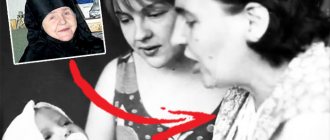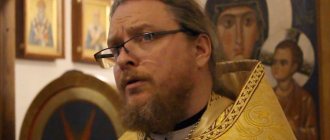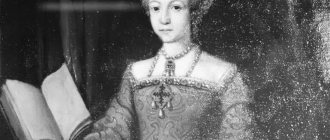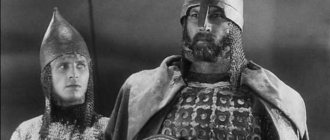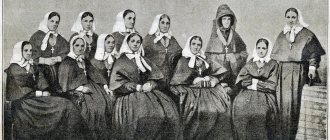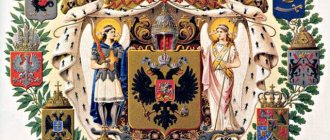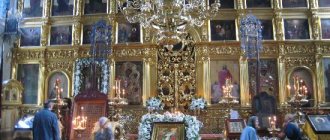| Passion-bearer Alexandra Feodorovna |
Alexandra Feodorovna
(1872 - 1918), Empress of All Russia, blessed queen, passion-bearer [1].
The wife of the All-Russian Emperor Nicholas I is known under the same name and patronymic.
Commemorated on July 4 on the day of death, in the Councils of the New Martyrs and Confessors of the Russian Church, Ekaterinburg, Kostroma and St. Petersburg Saints
She was born on May 25, 1872 in Darmstadt, in the family of the Grand Duke of Hesse Ludwig IV and Grand Duchess Alice, née Princess of Great Britain and Ireland, the second daughter of Queen Victoria of England. She was baptized into Lutheranism with the name Alice Victoria Elena Brigitte Louise Beatrice. In addition to Princess Alice, the family of Grand Duke Ludwig IV had children: Victoria, Ella (future Grand Duchess Martyr Elizabeth Feodorovna), Ernst Ludwig, Irena. The children's upbringing was supervised by their mother, a highly educated woman known for her charitable activities. During the diphtheria epidemic, Grand Duchess Alice contracted the disease while caring for the sick and died at the age of 35 on December 14, 1878. Having lost her mother, Princess Alice lived with her grandmother, Queen Victoria, from the age of 6. At the English court, she received an upbringing and a varied education; she spoke and wrote fluently in several languages. The family called her “sunbeam” for her cheerfulness and beauty. In her youth, Princess Alice attended lectures at the Faculty of Philosophy at the University of Heidelberg, where she received a bachelor's degree in philosophy. The culture of journaling and correspondence characterized Princess Alice from childhood.
In June 1884, 12-year-old Princess Alice visited Russia for the first time, attending the wedding of her sister, Princess Ella, and Grand Duke Sergei Alexandrovich. In January 1889, at the invitation of Grand Duke Sergei Alexandrovich, the princess again came to Russia with her brother and father. The guests spent 6 weeks at the Sergius Palace in St. Petersburg. The young princess aroused deep feelings in the heir to the Russian throne, Tsarevich Nikolai Alexandrovich, but the imperial family hoped for a marriage between the Tsarevich and the royal family of France; they wanted to see Elena Louise Henrietta, the daughter of Louis Philippe Bourbon of Orleans, Count of Paris, as the heir's bride. In August 1890, Princess Alice visited Grand Duchess Elisaveta Feodorovna in Ilinskoye, but the Tsarevich was unable to see her. In 1894, the health of Emperor Alexander III Alexandrovich sharply deteriorated, and the issue of succession to the throne and the marriage of the crown prince was resolved quickly.
On April 2, 1894, Nikolai Alexandrovich went to Coburg to propose to Princess Alice. He was accompanied by Protopresbyter John Yanyshev, confessor of the imperial family in 1883-1910, who was supposed to teach the princess the basics of Orthodoxy. E. A. Schneider, the teacher of Grand Duchess Elisaveta Feodorovna, was assigned to teach Princess Alice the Russian language. On April 8 of the same year, the engagement took place; Princess Alice and Tsarevich Nicholas spent 12 days in Coburg, Darmstadt, and then a month in England. Princess Alice considered her engagement to be the happiest event in her life; all that remained was to resolve the issue of converting to Orthodoxy. The princess was very religious and did not dare to change her Lutheranism, but the persistence of her sister, Grand Duchess Elizabeth Feodorovna, who joined Orthodoxy after 8 years of marriage, helped. At the request of the Grand Duchess, Protopresbyter John Yanyshev lived for six months at the Hessian court, studying and talking with Princess Alice every day, and subsequently became her confessor.
In the fall of 1894, alarming news about the health of Emperor Alexander III began to arrive in Darmstadt; on October 5, the princess received a telegram urgently summoning her to Russia. On October 10, she arrived in Crimea, in Livadia, where she stayed with the imperial family until October 20, the day of the death of Emperor Alexander III. On October 21, in the church of the Livadia Palace, Princess Alice was received into the fold of the Orthodox Church through confirmation and named Alexandra Feodorovna in honor of the martyr Queen Alexandra. On November 14 of the same year, on the birthday of Empress Maria Feodorovna, when deviations from strict mourning were allowed, the wedding of Emperor Nicholas II and Alexandra Feodorovna took place in the church of the Winter Palace. On May 14, 1896, the coronation of the royal couple took place in the Assumption Cathedral of the Moscow Kremlin.
| Holy Empress Alexandra Feodorovna |
Empress of All Russia
The Empress strove to become “ a true helper in all respects.”
» to his autocratic husband.
Protopresbyter of the military and naval clergy Georgy Shavelsky wrote that the empress saw “ in the person of her husband the sacred Anointed of God.
Having become the Russian queen, she managed to love Russia above her first homeland ” [2].
Subsequently, historians noted the theoretical mind of the empress and called her letters, which covered in detail the state of the Russian court and St. Petersburg, “ historical material of paramount importance
” [3].
The crowned family became a model of a truly Christian, united family. The imperial couple had 4 daughters: passion-bearers Grand Duchesses Olga Nikolaevna (November 3, 1895), Tatiana Nikolaevna (May 29, 1897), Maria Nikolaevna (June 14, 1899), Anastasia Nikolaevna (June 5, 1901). On July 30, 1904, the long-awaited heir to the throne, begged from God, was born - the passion-bearer Tsarevich Grand Duke Alexy Nikolaevich, to whom the hereditary disease of the descendants of Queen Victoria was transmitted - hemophilia. The empress took care of the upbringing and education of children, passed on to them her culture of correspondence and diary-keeping, and her religiosity. It is no coincidence that the royal family, according to historians, is “among the best documented in history” [4]. In addition to written sources, more than 150 thousand photographs of the imperial family, in which everyone had a personal camera, have been preserved; More than a thousand albums with photographs are known [5].
The Empress took care of the health of all family members, especially her son. She conducted the initial training of the heir independently, later invited outstanding teachers to him and observed the progress of the teaching. Thanks to the empress's great tact, the Tsarevich's illness was kept a family secret. Constant concern for the life of Alexy became the main reason for the appearance at the court of G. E. Rasputin, who had the ability to stop bleeding with the help of hypnosis, so in dangerous moments of illness he became the last hope for saving the child. The maternal torment of the empress and the desire to maintain peace in the family on the part of the tsar determined the role of Rasputin in the life of the court.
According to contemporaries, the empress was deeply religious. The church was her main consolation, especially at a time when the heir’s illness worsened. Lady-in-waiting S.K. Buxhoeveden noted that Empress Alexandra believed “in healing through prayer,” which she associated with her origins from the House of Hesse from Elizabeth of Thuringia (Hungary) (1207-1231), who established hospitals in Marburg, Eisenach, and Wartburg in the name of Great Martyr George and Saint Anna and who treated lepers [6]. The Empress held full services in the court churches, where she introduced the monastic liturgical regulations. Alexandra Feodorovna’s room in the palace was “ a connection between the empress’s bedroom and the nun’s cell. The huge wall adjacent to the bed was completely covered with images and crosses
"[7]. Under the images stood a lectern covered with ancient brocade. In July 1903, Nicholas II and Alexandra Feodorovna took part in the celebration of the glorification and opening of the relics of St. Seraphim of Sarov; a shrine and a canopy for the relics were built at the expense of the imperial family. A year before this, the Empress sent a lamp and church vestments to the Sarov Hermitage with a request to serve a daily prayer service for her health in the chapel built over the grave of St. Seraphim. She was sure that thanks to the prayers of the saint, Russia would receive an heir [8].
Through the efforts of the imperial family, several Orthodox churches were erected. In the homeland of Alexandra Feodorovna, in Darmstadt, a temple was built in the name of St. Mary Magdalene in memory of the first Russian Empress from the House of Hesse, Maria Alexandrovna. On October 4, 1896, in Hamburg, in the presence of Nicholas II, Alexandra Feodorovna, Grand Duchess Elisabeth Feodorovna, the Grand Duke of Hesse, in memory of the coronation of the Russian Emperor and Empress, a temple was founded in the name of All Saints. At their own expense, the imperial family, according to the design of architects S. S. Krichinsky and V. A. Pokrovsky, created the Feodorovsky town in the Alexander Park of Tsarskoye Selo with a court cathedral in the name of the Feodorovskaya Icon of the Mother of God, consecrated on August 20, 1912, where a prayer room with a lectern and chair for the empress. The underground church in the name of St. Seraphim of Sarov was a true treasury of ancient icon paintings and church utensils; it contained the Gospel of Tsar Theodore Ioannovich. Under the patronage of the empress, committees worked on the construction of churches in memory of sailors who died in the Russo-Japanese War of 1904-1905, and the Holy Trinity Cathedral in Petrograd.
One of the first undertakings of the empress, who became famous for her charitable activities, was the patronage of the imperial women's Patriotic Society, according to a rescript from Emperor Nicholas II of February 26, 1896. An unusually hard worker who devoted a lot of time to needlework, the empress organized charity fairs and bazaars where homemade souvenirs were sold. Under her patronage there were many charitable organizations: the House of Diligence with training workshops for cutting and sewing and a children's boarding school; Society for Labor Assistance to Educated Persons; House of hard work for educated women; Olginsky shelter of hard work for children of persons being treated at the hospital of St. Mary Magdalene; Trusteeship of the Imperial Humane Society to collect donations for the vocational education of poor children; Labor Aid Society "Uley"; Tsarskoe Selo Society of Handicrafts and School of Folk Art for teaching handicrafts; All-Russian Guardianship for the Protection of Motherhood and Infancy; Brotherhood in the name of the Queen of Heaven in Moscow (with it there was a shelter for 120 children - feeble-minded, crippled, epileptic - with a school, workshops, and a craft department); Shelter-nursery of the 2nd Temporary Committee for the Protection of Motherhood and Infancy; Shelter named after Empress Alexandra Feodorovna in Harbin; nursery of the Peterhof Charitable Society; 4th Petrograd Committee of the All-Russian Guardianship for the Protection of Motherhood and Infancy with a shelter for mothers and a nursery; “Nanny School” in Tsarskoe Selo, established at the personal expense of the Empress; Tsarskoye Selo Community of Sisters of Mercy of the Russian Red Cross Society (ROSC) and the House of the Empress for the charity of crippled soldiers; Holy Cross Community of Sisters of Charity ROKK; 1st Petrograd Ladies' Committee of the ROCC; Mikhailovsky, in memory of General M.D. Skobelev, a society for medical assistance to low-income wives, widows, children and orphans of soldiers (it had an outpatient clinic, an inpatient department, and a shelter for girls - orphans of soldiers); All-Russian Alexander Nevsky Brotherhood of Temperance (it has a school, a kindergarten, a holiday village, a book publishing house, folk choirs).
| Empress Alexandra Feodorovna, sister of mercy |
During the Russo-Japanese War, Alexandra Feodorovna personally prepared ambulance trains and warehouses of medicines to be sent to the theater of military operations.
The Empress suffered the greatest hardships during the First World War. Since the beginning of the war, Alexandra Feodorovna and her eldest daughters took courses in caring for the wounded in the Tsarskoye Selo community. In 1914-1915, the imperial train visited Moscow, Luga, Pskov, Grodno, Dvinsk (now Daugavpils), Vilna (now Vilnius), Kovno, Landvarovo, Novo-Sventsyany, Tula, Orel, Kursk, Kharkov, Voronezh, Tambov, Ryazan , Vitebsk, Tver, Likhoslavl, Rzhev, Velikiye Luki, Orsha, Mogilev, where the empress and her children visited wounded soldiers. Special trains were created for the empress's mobile and field warehouses. At each warehouse there was a camp church and a priest. To provide material support to wounded soldiers and their families, the Supreme Council for Charity of the Families of Persons Called up to the War, as well as the Families of Wounded and Fallen Soldiers, and the All-Russian Society of Health Resorts in Memory of the War of 1914-1915 were established. Under the patronage of the empress there were infirmaries: at the House of Diligence named after E. A. Naryshkina; at the Petrograd Orthopedic Institute; at the Mikhailovsky Society in memory of M.D. Skobelev and others. The Empress's Warehouse Committee worked in the Winter Palace from 1914 to 1917. Of exceptional interest for Russian culture, history, and science are objects of palace life, collections of antiquities, collections of books and works of art compiled by the empress and the august family. All imperial orders intended for palaces were unique, and duplicates were not allowed. The library of the Empress and Grand Duchesses in the Winter Palace consisted of about 2 thousand volumes, and manuscripts were also kept there. Alexandra Feodorovna’s books were also in Livadia, Tsarskoye Selo, they are marked with a bookplate and are works of publishing and bookbinding art. The support of Alexandra Feodorovna and the entire imperial family of the Faberge firm became a prerequisite for the emergence of a new direction in applied art - the “imperial style”, “Faberge design and style”. The Empress collected antiquities and assisted scientists. She received an honorary diploma from the Archaeological Institute, the committee for the construction of the Museum of Fine Arts named after Emperor Alexander III in Moscow elected her an honorary member for her active assistance to the museum, and the Pergamon Hall of the museum was named in honor of the empress. Under the patronage of the empress was the Imperial Society of Oriental Studies, which had the goal of “ distributing accurate and correct information about Russia among the eastern peoples, as well as familiarizing Russian society with the material needs and spiritual life of the East.”
" Alexandra Feodorovna was a skilled artist; icons embroidered by her were preserved in the Church of St. Mary Magdalene in Darmstadt. By the beginning of 1903, she made drawings of a Russian costume for a charity ball in the Winter Palace, in consultation with the director of the Hermitage I. A. Vsevolozhsky. The Empress was dressed in gold brocade clothes, created according to sketches from the clothes of Tsarina Maria Ilyinichna. Another work of Alexandra Feodorovna is a drawing of a sign for parts of the imperial convoy. The Empress collected works of laminated glass and personally gave production instructions to the imperial porcelain and glass factories.
In the last years of her reign, especially during the First World War, Alexandra Feodorovna became the subject of a ruthless and baseless slander campaign led by revolutionaries and their collaborators in both Russia and Germany. Rumors were widely spread about the empress's adultery, about her allegedly unchaste relationship with Rasputin, about her betrayal of the Motherland in favor of Germany. This lie, whipped up in order to overthrow the royal house and embarrass the Russian people, at one time became widespread not only in popular but also in scientific publications. However, despite the fact that the sovereign knew about the purity of the empress’s personal life, he also personally ordered a secret investigation into “slanderous rumors about the empress’s relations with the Germans and even about her betrayal of the Motherland.” Although in the pre-war period the Empress did support improving relations with Germany, it was established that rumors about the desire for a separate peace with the Germans, the transfer of Russian military plans by the Empress to the Germans, were spread by the German General Staff. After the abdication of the sovereign, the Extraordinary Commission of Inquiry under the Provisional Government tried and failed to establish the guilt of Nicholas II and Alexandra Feodorovna of any crimes.
However, the denigration of the image of the royal family, the widespread loss of faith and loyalty to it, and the obvious desire of broad layers of the empire's elite to abandon the monarchical structure of the state led to the removal of the imperial family from power. On March 2, 1917, Emperor Nicholas II abdicated the throne for himself and for Tsarevich Alexy.
Imprisonment and martyrdom
On March 8, 1917, by order of the Provisional Government, the empress and her children were arrested by General L. G. Kornilov in Tsarskoe Selo, on the same day the sovereign was arrested in Mogilev, and on March 9 he was taken to Tsarskoe Selo under escort. On August 1 of the same year, the royal family left the Alexander Palace of Tsarskoye Selo for exile in Tobolsk, where they lived for 8 months in prison in the governor’s house.
In captivity, Alexandra Feodorovna taught children the Law of God, foreign languages, was engaged in needlework, painting, and reading spiritual books. Common prayer united the family, whose life was determined by faith, hope and patience. Surrounded by enemies, the prisoners turned to spiritual literature, strengthened themselves with the examples of the Savior and the holy martyrs, and prepared for martyrdom. While in prison, the Empress gave the children books: “The Life and Miracles of the Holy Righteous Simeon of Verkhoturye”, “The Life of Our Reverend Father Seraphim of Sarov”, “Consolation in the Death of Those Close to the Heart”, “On the Patience of Sorrows”, “The Benefits of the Mother of God to the Human Race Through Her Saints” icons." Numerous notes in the books, especially in the books of the empress, testified to the high spiritual state of the royal family - faith, humility, forgiveness, the desire to be faithful to the covenants of the Lord [9]. Among Alexandra Feodorovna’s books were “The Ladder” by St. John Climacus, “On the Patience of Sorrows, the Teaching of the Holy Fathers, collected by Bishop Ignatius Brianchaninov,” a Prayer Book and the Bible [10].
On April 26, 1918, the sovereign, empress and Grand Duchess Maria Nikolaevna, by order, left Moscow for Yekaterinburg, leaving them in the care of the older sisters of the sick Alexy; on April 30, they were imprisoned in a house that previously belonged to engineer N.K. Ipatiev. The Bolsheviks called it a “house of special purpose” and the prisoners - “tenants”. The house, surrounded by a high fence, was guarded by more than 30 people. On May 23, at 2 o'clock in the morning, Grand Duchesses Olga, Tatiana, Anastasia and Grand Duke Alexy were also taken to Yekaterinburg. The life of the royal family was subject to the prison regime: isolation from the outside world, meager food rations, an hour-long walk, searches, hostility from the guards.
On July 12, under the pretext of the Czechoslovak Corps and units of the Siberian Army approaching Yekaterinburg, the Bolshevik Urals Council adopted a resolution to kill the royal family. There is an opinion that the military commissar of the Urals F.I. Goloshchekin, who visited Moscow at the beginning of July 1918, received V.I. Lenin’s consent to this. On July 16, a telegram was sent to Lenin in which the Urals Council reported that the execution of the royal family could no longer tolerate delay, and asked to immediately inform whether Moscow had any objections. Lenin did not respond to the telegram, which the Urals Council may have considered as a sign of agreement. The leadership of the execution of the resolution was taken over by Ya. M. Yurovsky, who on July 4 was appointed to the post of commandant of the “special purpose house.”
During this tragic time, the empress was distinguished by extraordinary greatness of spirit and “ amazingly bright calm, which then supported her and her entire family until the day of their death.”
" [eleven].
On July 16, a few hours before the execution, she wrote in her diary: “ Tatiana was reading spiritual literature.
Everybody left. Tatyana stayed with me and read: the holy prophet Amos and the prophet Obadiah " [12].
The murder of the royal family and their entourage followed on the night of July 16-17, 1918. At 2 a.m., the prisoners were woken up and ordered to go down to the semi-basement floor of the house, where the royal family was shot by armed executioners from the Cheka. According to their testimony, the empress and eldest daughters managed to cross themselves before their death. The Tsar and Empress were killed first. They did not see the execution of their children, who were finished off with bayonets. Commissar of Supply of the Ural Region P.L. Voikov, who stole the ruby ring donated by the sovereign from the body of the empress, delivered sulfuric acid and gasoline to destroy the bodies of those killed in the old mine shafts of the Four Brothers tract.
| Royal New Martyrs. |
Childhood and youth
The future empress was born on May 25, 1872, in the German city of Darmstadt. Her father was the Grand Duke of Hesse, Ludwig IV, and her mother was the Grand Duchess Alice, the second daughter of Queen Victoria of England. The girl was baptized Lutheran and received the name Alice Victoria Elena Brigitte Louise Beatrice, in honor of her mother and aunts. The family began to call the girl simply Alice. The mother was raising the child. But when Alice was only six years old, her mother died. She cared for patients with diphtheria and became infected herself. At that time, the woman was only 35 years old.
After losing her mother, Alice began to live with her grandmother Queen Victoria. In the English court, the girl received a good upbringing and education. She was fluent in several languages. In her youth, the princess received a philosophical education at the University of Heidelberg.
In the summer of 1884, Alexandra visited Russia for the first time. She came there for the wedding of her sister, Princess Ella, with Prince Sergei Alexandrovich. At the beginning of 1889, she visited Russia again with her brother and father. Tsarevich Nikolai Alexandrovich, who was the heir to the throne, fell in love with the young princess. However, the imperial family did not attach any importance to this, in the hope that he would connect his life with the royal family of France.
The health of the empress and the birth of daughters
It was impossible to hide the poor health of the empress from the courtiers. To alleviate her suffering, the Tsar ordered the construction of a special room in the Alexander Palace, where the Tsarina took sulfur baths, which brought her temporary relief.
The emperor spared no expense on the treatment of his wife: a doctor was assigned to her, and an orthopedic institute was founded to develop new treatment methods. Childbirth had a negative impact on Alexandra Feodorovna’s health. She gave birth to four daughters one after another, each pregnancy worsened the empress’s well-being.
During the pregnancy of the heirs to the throne, the best gynecologists and midwives were on duty near Queen Alexandra.
Wedding
In 1894, when the condition of Emperor Alexander III sharply deteriorated, it was necessary to suddenly resolve the issue of the prince’s marriage and succession to the throne. On April 8, 1894, Princess Alice was engaged to Tsarevich Nicholas. On October 5 of the same year, she received a telegram asking her to urgently come to Russia. Five days later, Princess Alice was in Livadia. Here she stayed with the royal family until October 20, the day when Alexander III died. The next day, the princess was accepted into the fold of the Orthodox Church and named Alexandra Feodorovna, in honor of Queen Alexandra.
On the birthday of Empress Maria, November 14, when it was possible to retreat from strict mourning, Alexandra Romanova married Nicholas II. The wedding took place in the Church of the Winter Palace. And on May 14, 1896, the royal couple was crowned in the Assumption Cathedral.
Empress Alexandra Feodorovna
Alice first saw Nicky at her sister's wedding. She was only 12 years old then. The young princess really liked this well-mannered and subtle young man, the mysterious Russian prince, so different from her British and German cousins.
She met Nikolai Alexandrovich Romanov for the second time in 1889. Alice went to Russia at the invitation of her sister’s husband, Grand Duke Sergei Alexandrovich, Nikolai’s uncle. A month and a half spent in the St. Petersburg Sergius Palace and meetings with Nikolai turned out to be enough time to understand: she had met her soul mate.
Alexandra Feodorovna and Nicholas II
Only their sister Ella-Elizaveta Fedorovna and her husband were happy with their desire to unite their destinies. They became a kind of communicators between lovers, facilitating their communication and secret correspondence.
Grandmother Victoria, who did not know about her secretive granddaughter’s personal life, planned her marriage to her cousin Edward, Prince of Wales. The elderly woman dreamed of seeing her beloved “Sunny” become the Queen of Britain, to whom she would transfer her powers.
Edward, Prince of Wales (Edward VII)
But Aliki, in love with a distant Russian prince, calling the Prince of Wales “Eddie-cuffs” for excessive attention to his manner of dressing and narcissism, confronted Queen Victoria with a fact: she would only marry Nicholas. The letters shown to the grandmother finally convinced the disgruntled woman that she could not keep her granddaughter.
The parents of Tsarevich Nicholas were not delighted with their son’s desire to marry a German princess. They hoped for their son's marriage to Princess Helena Louise Henrietta, daughter of Louis Philippe. But the son, like his bride in distant England, showed persistence.
Alexandra Feodorovna and Nicholas II
Alexander III and his wife surrendered. The reason was not only Nicholas’s persistence, but also the rapid deterioration of the sovereign’s health. He was dying and wanted to hand over the reins to his son, who would have his personal life organized. Alisa was urgently called to Russia, to Crimea.
The dying emperor, in order to meet his future daughter-in-law as best as possible, with the last of his strength got out of bed and put on his uniform. The princess, who knew about the state of health of her future father-in-law, was moved to tears. They began to urgently prepare Alix for marriage. She studied Russian and the basics of Orthodoxy. Soon she accepted Christianity, and with it the name Alexandra Feodorovna (Feodorovna).
Emperor Alexander III
Emperor Alexander III died on October 20, 1894. And on October 26, the wedding of Alexandra Fedorovna and Nikolai Alexandrovich Romanov took place. The bride's heart sank from such haste and a bad feeling. But the Grand Dukes insisted on the urgency of the wedding.
To preserve decency, the wedding ceremony was scheduled for the birthday of Empress Maria Feodorovna. According to existing canons, deviation from mourning on such a day was allowed. Of course, there were no receptions or big celebrations. The wedding turned out to have a mournful tint. As Grand Duke Alexander Mikhailovich later wrote in his memoirs:
“The couple’s honeymoon proceeded in an atmosphere of funeral services and mourning visits. The most deliberate dramatization could not have invented a more suitable prologue for the historical tragedy of the last Russian Tsar.”
The second gloomy omen, from which the heart of the young empress again sank in anguish, happened in May 1896, during the coronation of the royal family. A famous bloody tragedy occurred on the Khodynka field. But the celebrations were not cancelled.
Stampede on Khodynka Field
The young couple spent most of their time in Tsarskoye Selo. Alexandra Fedorovna felt good only in the company of her husband and her sister’s family. Society received the new empress coldly and with hostility. The unsmiling and reserved empress seemed arrogant and prim to them.
To escape from unpleasant thoughts, Alexandra Fedorovna Romanova eagerly took up public affairs and became involved in charity work. Soon she had several close friends. In fact, there were very few of them. These are Princess Maria Baryatinskaya, Countess Anastasia Gendrikova and Baroness Sofia Buxhoeveden. But her closest friend was Anna Vyrubova, the maid of honor.
Anna Vyrubova and Alexandra Fedorovna
The happy smile returned to the empress when her daughters Olga, Tatyana, Maria and Anastasia appeared one after another. But the long-awaited birth of an heir, the son of Alexei, returned Alexandra Feodorovna to her usual state of anxiety and melancholy. My son was diagnosed with a terrible hereditary disease - hemophilia. It was inherited through the empress's line from her grandmother Victoria.
The bleeding son, who could die from any scratch, became a constant pain for Alexandra Feodorovna and Nicholas II. At this time, Elder Grigory Rasputin appeared in the life of the royal family. This mysterious Siberian man really helped the Tsarevich: he alone could stop the bleeding, which the doctors were not able to do.
Anna Vyrubova, Grigory Rasputin and Alexandra Fedorovna
The approach of the elder gave rise to a lot of rumors and gossip. Alexandra Fedorovna did not know how to get rid of them and protect herself. Word spread. Behind the empress's back they whispered about her supposedly undivided influence on the emperor and public policy. About Rasputin's witchcraft and his connection with Romanova.
The outbreak of the First World War briefly plunged society into other concerns. Alexandra Fedorovna threw all her resources and strength into helping the wounded, widows of dead soldiers and orphaned children. The Tsarskoye Selo hospital was rebuilt as an infirmary for the wounded. The Empress herself, together with her eldest daughters Olga and Tatiana, were trained in nursing. They assisted in operations and cared for the wounded.
Alexandra Feodorovna and Princess Vera Gedroits in the dressing room of the Tsarskoye Selo hospital in 1915
And in December 1916, Grigory Rasputin was killed. How Alexandra Feodorovna was “loved” at court can be judged from a surviving letter from Grand Duke Nikolai Mikhailovich to the empress’s mother-in-law, the Dowager Empress Maria Feodorovna. He wrote:
“All of Russia knows that the late Rasputin and Empress Alexandra Feodorovna are one and the same. The first one is killed, now the other one must disappear too.”
As Anna Vyrubova, a close friend of the Empress, later wrote in her memoirs, the Grand Dukes and nobles, in their hatred of Rasputin and the Empress, themselves sawed off the branch on which they sat. Nikolai Mikhailovich, who believed that Alexandra Feodorovna “must disappear” after the elder, was shot in 1919 along with three other Grand Dukes.
Children
Tsarina Romanova Alexandra Fedorovna tried to be an assistant for her husband in all his endeavors. Together, their union became a true example of a truly Christian family. The couple gave birth to four daughters: Olga (in 1895), Tatyana (in 1897), Maria (in 1899), Anastasia (in 1901). And in 1904, a long-awaited event for the whole family took place - the birth of the heir to the throne, Alexei. He was given the disease that Queen Victoria's ancestors suffered from - hemophilia. Hemophilia is a chronic disease associated with poor blood clotting.
Nicholas II and Alexandra Fedorovna
Nicholas and Alexandra lived in Tsarskoe Selo, in a private imperial residence. At first they enjoyed a calm and happy family life. Until this life was destroyed by the serious illness of their son and two wars that ended with the collapse of the Russian Empire.
By the first year of 1901, the couple Nikolai and Alexandra already had four children, but they were all girls. The Romanov family needed an heir and Alexandra reached despair in trying to give her husband a son. She turned to sorcerers and priests to conceive a boy - but to no avail. Alexandra brought herself to the point that in 1903 she had a false pregnancy. Finally, in 1904, she gave birth to Nikolai’s son, who was named Alexei. But the joy in the family was short-lived. It soon became known that the Tsarevich had hemophilia.
Upbringing
Empress Alexandra Romanova tried to take care of the whole family, but she paid special attention to her son. Initially, she taught him on her own, later she called teachers and supervised the progress of his training. Being very tactful, the empress kept her son’s illness a secret from outsiders. Due to constant concern for Alexy’s life, Alexandra invited G.E. Rasputin, who knew how to stop bleeding using hypnosis, to the courtyard. In dangerous moments, he was the family's only hope.
Place at court and in political life
From the very first day of her reign, Empress Alexandra Feodorovna was support and support for her husband in his difficult state affairs.
In public life, the young woman tried to encourage people to give to charity, something she had learned from her parents as a child. Unfortunately, her ideas were not accepted at court; moreover, the empress was hated. The courtiers saw deceit and unnaturalness in all her proposals and even her facial expressions. But in fact, they were simply accustomed to idleness and did not want to change anything.
Of course, like any woman and wife, Alexandra Romanova influenced her husband’s government activities.
Many prominent politicians of that time noted that she had a negative influence on Nicholas. This was the opinion, for example, of S. Witte. And General A. Mosolov and Senator V. Gurko regretfully note its non-acceptance by Russian society. Moreover, the latter blames not the capricious character and some nervousness of the current empress, but the widow of Alexander III, Maria Fedorovna, who never fully accepted her daughter-in-law.
Nevertheless, her subjects obeyed her, and not out of fear, but out of respect. Yes, she was strict, but she was the same towards herself. Alix never forgot her requests and instructions, each of them was clearly thought out and balanced. Those who were close to the empress sincerely loved her and knew her not by hearsay, but deeply personally. For others, the empress remained a “dark horse” and the subject of gossip.
There were also very warm reviews about Alexander. Thus, the ballerina M. Kshesinskaya (by the way, she was Nikolai’s mistress before the latter’s wedding to Alix) mentions her as a woman of high morality and a broad soul.
Religion
As contemporaries testified, Empress Alexandra Feodorovna Romanova, the wife of Nicholas 2, was very religious. In the days when the heir’s illness worsened, the church was her only salvation. Thanks to the imperial family, several temples were built, including in Alexandra’s homeland. Thus, in memory of Maria Alexandrovna, the first Russian Empress from the House of Hesse, the Church of Mary Magdalene was erected in the city of Darmstadt. And in memory of the coronation of the Emperor and Empress, in 1896, a temple in the name of All Saints was founded in the city of Hamburg.
First World War and Revolution
When World War I led to conflict between Russia and Germany, Nicholas II went to the front, where he took personal command of the armed forces. Alexandra Feodorovna remained as regent and was supposed to supervise the work of the government. Trusting Rasputin limitlessly, she made him her advisor. Guided by Rasputin's instructions, Alexandra fired experienced ministers, replacing them with new, incompetent people.
The Russian army performed very poorly during the fighting. This served to spread rumors that Alexandra was a secret agent for Germany, which further aggravated her already difficult position in society. On December 16, 1916, Rasputin was killed by conspirators from the royal court. Left without her husband and without her main adviser, Alexandra began to lose emotional stability.
Charity
According to the rescript of her husband, dated February 26, 1896, the Empress took up the patronage of the imperial women's Patriotic Community. Being unusually hardworking, she devoted a lot of time to needlework. Alexandra Romanova organized charity bazaars and fairs where homemade souvenirs were sold. Over time, she took many charities under her patronage.
During the war with the Japanese, the Empress was personally involved in the preparation of ambulance trains and warehouses of medicines to be sent to the battlefields. But Alexandra Fedorovna Romanova carried out the greatest labors during the First World War. From the very beginning of the confrontations, in the Tsarskoye Selo community, together with her eldest daughters, the empress took courses in caring for the wounded. Later, they more than once saved the military from painful death. In the period from 1914 to 1917, the Empress's Warehouse Committee worked in the Winter Palace.
The spiritual appearance of Alexandra Romanova
Was Alexandra Romanova really a deeply religious person? Photos and portraits of the empress that have survived to this day always show the sad eyes of this woman; some kind of sorrow lurks in them. Even in her youth, she fully embraced the Orthodox faith, abandoning Lutheranism, the truths of which she had been brought up with since childhood.
Life's upheavals bring her closer to God; she often retires to pray when she is trying to conceive a boy, and then when she learns about her son's fatal illness. And during the war, she frantically prays for the soldiers who were wounded and died for their Motherland. Every day before her service in the hospital, Alexandra Fedorovna sets aside a certain time for prayer. For these purposes, the Tsarskoye Selo Palace even has a special prayer room.
However, her service to God consisted not only in diligent prayers: the empress launched truly large-scale charitable activities. She organized an orphanage, a home for the disabled, and numerous hospitals. She found time for her maid of honor, who had lost the ability to walk: she talked with her about God, spiritually instructed and supported her every day.
Alexandra Fedorovna never flaunted her faith; most often, when traveling around the country, she visited churches and hospitals incognito. She could easily merge with the crowd of believers, because her actions were natural, coming from the heart. Religion was a purely personal matter for Alexandra Fedorovna. Many at court tried to find notes of hypocrisy in the queen, but nothing worked.
So was her husband, Nicholas II. They loved God and Russia with all their hearts, and could not imagine another life outside of Russia. They made no distinctions between people, did not draw a line between titled persons and ordinary people. Most likely, this is why an ordinary Tobolsk man, Grigory Rasputin, at one time “took root” in the imperial family.
Abdication
On March 2, 1917, Nicholas II abdicated the throne personally for himself and for his heir, Tsarevich Alexei. Six days later, in Tsarskoe Selo, Alexandra Romanova was arrested along with her children. On the same day, the emperor was arrested in Mogilev. The next day, a convoy took him to Tsarskoe Selo. That same year, on August 1, the whole family left for exile in Tobolsk. There, imprisoned in the governor's house, she lived for the next eight months.
On April 26 of the following year, Alexandra, Nikolai and their daughter Maria were sent to Yekaterinburg, leaving Alexei's three sisters in the care. Four days later, they were settled in a house that previously belonged to engineer N. Ipatiev. The Bolsheviks called it “a special purpose house.” And they called the prisoners “tenants.” The house was surrounded by a high fence. It was guarded by 30 people. On May 23, the remaining children of the imperial family were brought here. The former sovereigns began to live like prisoners: complete isolation from the outside environment, meager food, daily hour-long walks, searches, and a biased hostile attitude from the guards.
Birth of an heir
The only thing that darkened the life of the spouses was the absence of an heir. Alexandra Romanova was very worried about this. On such days she became especially nervous. Trying to understand the reason and solve the problem, the empress begins to get involved in mysticism and gets even more involved in religion. This also affects her husband, Nicholas II, because he feels the mental torment of the woman he loves.
It was decided to attract the best doctors. Unfortunately, among them there was a real charlatan, Philip. Arriving from France, he so inspired the empress with thoughts of pregnancy that she really believed that she was carrying an heir. Alexandra Fedorovna developed a very rare disease - “false pregnancy”. When it became clear that the Russian Tsarina’s belly was growing under the influence of a psycho-emotional state, an official announcement had to be made that there would be no heir. Philip is expelled from the country in disgrace.
A little later, Alix nevertheless conceives and gives birth to a boy, Tsarevich Alexei, on August 12, 1904.
But she did not receive the long-awaited happiness of Alexander Romanov. Her biography says that the empress’s life from that moment on became tragic. The fact is that the boy is diagnosed with a rare disease - hemophilia. This is a hereditary disease, the carrier of which is a woman. Its essence is that blood does not clot. The person is overcome by constant pain and attacks. The most famous carrier of the hemophilia gene was Queen Victoria, nicknamed the grandmother of Europe. For this reason, this disease received the following names: “Victorian disease” and “Royal disease”. With the best care, the heir could live to a maximum of 30 years, but on average, patients rarely surpassed the age barrier of 16 years.
Murder of the royal family
On July 12, 1918, the Bolshevik Uralsovet, under the pretext of the approach of the Czechoslovak and Siberian armies, adopted a resolution on the murder of the imperial family. There is an opinion that the Ural military commissar F. Goloshchekin at the beginning of the same month, having visited the capital, enlisted the support of V. Lenin for the execution of the royal family. On June 16, Lenin received a telegram from the Uralsovet, which reported that the execution of the Tsar’s family could no longer be delayed. The telegram also asked Lenin to immediately communicate his opinion on this matter. Vladimir Ilyich did not answer, and it is obvious that the Urals Council considered this as agreement. The execution of the decree was led by Y. Yurovsky, who on July 4 was appointed commandant of the house in which the Romanovs were imprisoned.
On the night of July 16-17, 1918, the murder of the royal family followed. The prisoners were woken up at 2 a.m. and ordered to go down to the basement of the house. There the entire family was shot by armed security officers. According to the testimony of the executioners, Empress Alexandra Feodorovna Romanova, together with her daughters, managed to cross herself before her death. The Tsar and Tsarina were the first to fall at the hands of the Chekists. They did not see how the children were finished off with bayonets after the execution. The bodies of those killed were destroyed using gasoline and sulfuric acid.
Personal life
There are still many rumors about the royal family and the joint life of Alexandra Feodorovna and Nicholas II, which go back to the distant past. Gossip arose in the immediate circle of the monarchs. Ladies-in-waiting, princes and their gossip-loving wives happily came up with various “defamatory connections” in which the Tsar and Tsarina were allegedly caught. It seems that Princess Zinaida Yusupova “tried” the most to spread rumors.
Alexandra Fedorovna with her daughters
After the revolution, a fake came out, passed off as the memoirs of a close friend of the empress, Anna Vyrubova. The authors of this dirty libel were very respected people: Soviet writer A. N. Tolstoy and history professor P. E. Shchegolev. These “memoirs” talked about the empress’s vicious connections with Count A.N. Orlov, with Grigory Rasputin and Vyrubova herself.
There was a similar plot in the play “The Empress’s Conspiracy,” written by these two authors. The goal was clear: to discredit the royal family as much as possible, remembering which the people should not regret, but be indignant.
Alexandra Feodorovna and Nicholas II with children
But the personal life of Alexandra Feodorovna and her lover Nika, nevertheless, turned out great. The couple managed to maintain tremulous feelings until their death. They adored their children and treated each other with tenderness. The memories of their closest friends, who knew firsthand about the relations in the royal family, were preserved about this.
Investigation
The circumstances of the murder and destruction of the body became known after Sokolov’s investigation. Individual remains of the imperial family, which Sokolov also found, were transferred to the Temple of Job the Long-Suffering, built in Brussels in 1936. In 1950, it was consecrated in memory of Nicholas II, his relatives and all the new martyrs of Russia. The temple also contains the found rings of the imperial family, icons and the Bible, which Alexandra Feodorovna gave to her son Alexei. In 1977, due to the influx of ladles, the Soviet authorities decided to destroy Ipatiev's house. In 1981, the royal family was canonized by the foreign Russian Orthodox Church.
In 1991, in the Sverdlovsk region, a burial was officially opened, which was discovered by G. Ryabov in 1979 and mistook for the grave of the royal family. In August 1993, the Russian Prosecutor General's Office opened an investigation into the murder of the Romanov family. At the same time, a commission was created to identify and subsequently rebury the found remains.
In February 1998, at a meeting of the Holy Synod of the Moscow Patriarchate, it was decided to bury the found remains in a symbolic grave-monument as soon as any grounds for doubt regarding their origin disappeared. Ultimately, the secular authorities of Russia decided to rebury the remains on July 17, 1998 in the St. Petersburg Peter and Paul Cathedral. The funeral service was led personally by the rector of the cathedral.
At the Council of Bishops in 2000, Alexandra Fedorovna Romanova, whose biography became the subject of our conversation, and the rest of the royal passion-bearers, were canonized in the Council of Russian New Martyrs. And on the site of the house in which the royal family was executed, a Monument Temple was built.
“There is no one next to Niki...”
On January 9, 1905, a delegation of workers led by priest Georgy Gapon was shot in St. Petersburg. This day went down in history as “Bloody Sunday” - the event that marked the beginning of the revolution of 1905. Alexandra Feodorovna first came face to face with domestic politics; she was distraught, as her letter to her sister Victoria of Battenberg (January 27, 1905) shows: “You can understand the crisis we are going through now! ...My poor Nicky finds this cross too hard to bear, especially since he has no one next to him who could give him real support or on whom he could completely rely. ...On my knees I pray to the Lord to give me wisdom that would allow me to help my husband in solving this difficult task. I’m racking my brain about where to find the right person for the government, and I can’t think of anything.” The Empress complained about the lack of personnel: “Now there is simply no one to choose from: some are too old, others are too young. Grand dukes are not suitable, and our dear Misha is still a child...” It is quite obvious that Alexandra Feodorovna (as well as other representatives of the political layer of the Russian Empire) was taken by surprise by the revolution. For the first time she touched upon the topic of appointing ministers, which was new to her: she had not previously encountered this area. Alexandra Fedorovna seeks to share the burden of power, thereby easing it for Nicholas II, but at the same time noted the personnel vacuum that has formed in the country’s political elite. She laid the blame for this on Alexander III: “If his father had communicated with a large number of people in his time, he could have gathered the best of them around his son, and now we would have the necessary candidates for the most important posts”8.
It is interesting how Alexandra Fedorovna assessed the reasons for the outbreak of the revolution. She believed that "Bloody Sunday" was a provocation because of which the "poor workers" were forced to suffer; in her opinion, “the Russian people are completely devoted to their Sovereign, and revolutionaries use his name to set the peasants against the landowners, etc. “I just don’t know how they do it.”9 This belief in the loyalty of the people to their monarch can be traced more than once in the empress’s letters. Again she expressed a desire to ease the burden of power that her husband bore: “I wish I could be really smart so I could give Nicky real support!”10
Thus, during the years of the first Russian Revolution, the Empress began to become interested in political issues and, as a loving wife, wanted to help her husband “carry this cross” during a period of acute political crisis. Even then, Alexandra Fedorovna began to think about searching for candidates for this or that position, but so far she had not proposed specific individuals to Nicholas II.
